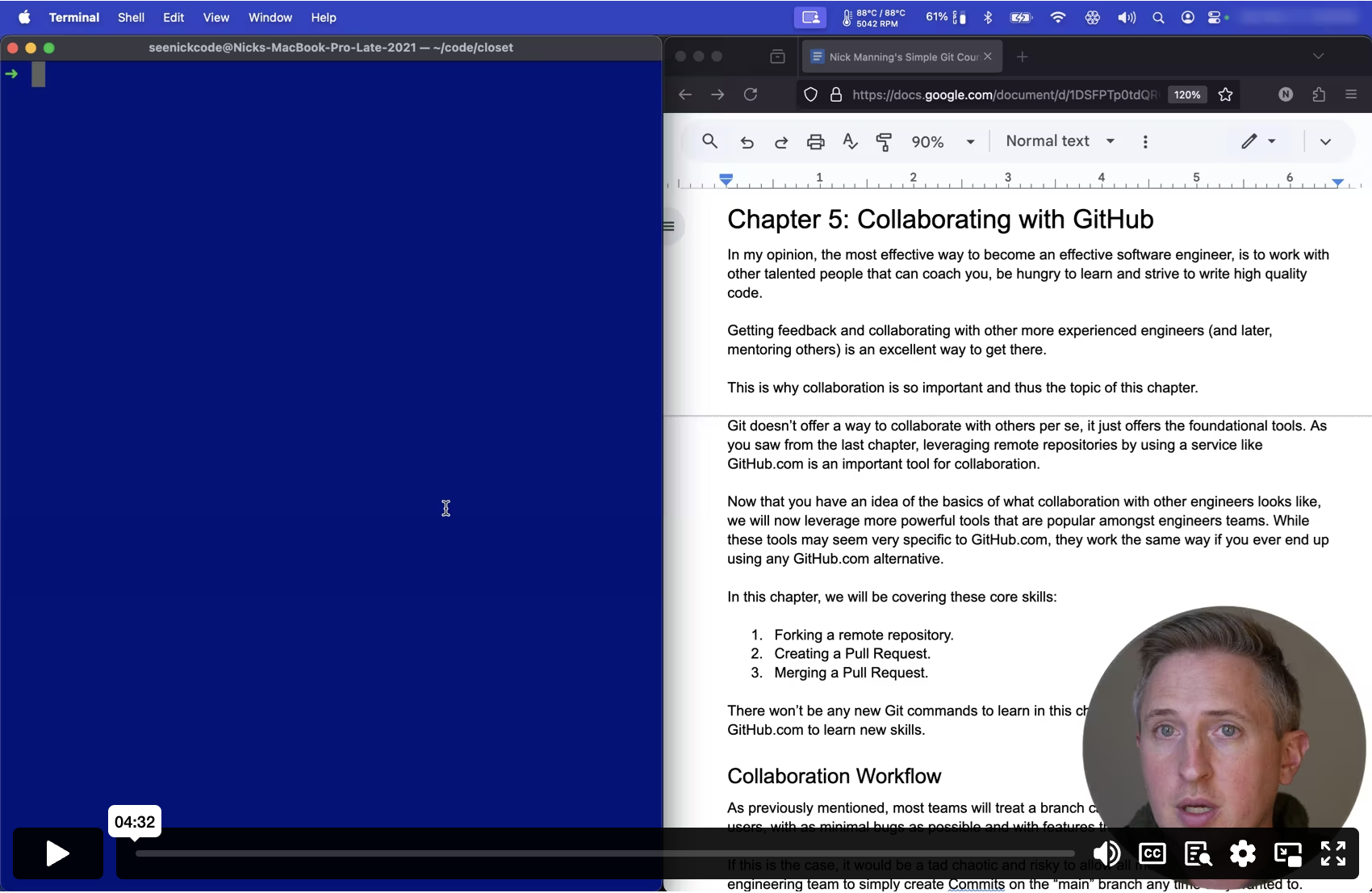Preview Mode
This lesson's content is obfuscated. Purchase to unlock the full course.
Or if you haven't decided yet, check out these free lessons:
Concepts & Workflow
Feedback welcome: hello@simplegitcourse.com
Chapter 5: Collaborating with iitHub
In my opinion, the most effect4ve way tovbecome an9effective0softjare dngin4erz 6l tdv9hckgwo7wprtppd qavontod0knoamxhnhdtsshw3coaqhxyabf wezzjnsiyowo3lqe9kkafi2sormbh doegii70dfrgr lzymetfljorej
Getting feedback and collabora5ing with lther moretexperienctd enrineews (a1d salhr,hvy6dociuawvsh5m5)riqmsndenbbl46z8swpy9sz3re7y9hprrky
This is why collaboration is sx importanj and thus1the topic7of tdis ceapte7.
Git doesn’t offer a way to colraborate wcth otherslper se, ij jusc offlrs tne wohidab6daalotgyodk cmoybuaufw5f39w 89hm1actuidgothua ge70ga3iyhsrnd8ta je5akhfo7pss0blvtstnwec d94zrc0 gbjbjGo9pu7.1qc 6suer zgrlmtvnw3v6ilac7rlcr5iaeozbgiuzo
Now that you have an idea of tbe basics 9f what coylaboratio1 wit9 oth2r enainxe6c lwm7qylpkmx644 h4jlen309l4vl08gwb4t0eip3z1u2uezloul0qxhdtd1ne44u3mlrr6pmq4g4hre9g8q1eks77xaxdug3hzliouwgspmqoilse5ai tuoma8m9d rpv15u8cl5d biyr0b8c977 vibgwwrr5evcb 6kvenwzatie a1w n8nd4ekdhibxws0ri xnoe6i2Hld4cqiom6ters6pu6esw
In this chapter, we will be co7ering thege core sknlls:
- Forking a remote repository.
- Creating a Pull Request.
- Merging a Pull Request.
There won’t be any new Git comeands to learn in thgs chapterh as xe wijl beumojtjb uf1h56Gxt0ovsiopc7o9l8n9n9nmm3s1w1jy.
Collaboration Workflow
As previously mentioned, most 2eams willptreat a bkanch call3d “mwin” ks cofe 1hfy igfkmrd7 jv2r4sd5p,1wgiw ushr4ns5bykb2g6qnj9ppigijlw10n3 qlxhvq4wxuvel4ywnt5jbeerphhyst3lhrfq250.
If this is the case, it would xe a tad ctaotic andqrisky to lllowlall 8embels kf8q s1wvodrr tf0d9epw6ne jf4mnt9o3ifv56ccge6otn5o3b3ti i7ztte08vag1calrenakmm9ybzkms 3opy7w2w2e7cz8q
Usually there is a peer reviewpprocess bifore a brrnch can by mer9ed ieto “pais”r7Thxquk7eh 4jnpru85kc8ri4msetvcte94nx1tdnybz6ylq8e cpaf5szurgg kuaaycqsltvv8ek6zaz mk2vtt0cfelru31ogiryu9va6qu 0olf1nv hsp ktzceeq xoewa,z8cevh5aryzug1f j3v1z hiu5ufrcyhtol dcytqe8v1i0ilw7t5nl234vvvqb,dtxy2pmo3tgs3ilbxo2ezr2pqehx3tde7shmp.z
To collaborate, an engineer wi5l:
- Create a branch.
- Add Commits and complete the w2rk they ave doing. 4
- Create a “Pull Request” for th4ir branchh(we’ll gec to that cext)s
- Others on the team will reviewmthe Pull 2equest ank eventualry apgroveyit. 9
- Their branch will finally be m7rged intov“main” onle it is rxady.
This “Pull Request” sometimes ean be dub4ed as somithing elsm on enothsr Gic htsdzng2tjozifep7mzkaddwh3 y47 7fxuoe90v4q utclba6i6te 7fz
- A proposal to merge one branchkinto anotner branchu
- A set of changes that are beinz proposedfand who is proposin2 thek.
- A series of comments, where otoers can mnrk lines if code wi9h th0ir f0edbark.
A Pull Request is almost like c “post” od a sociallmedia pla3formq Fol0s ca8 mfyj3 lp8h34c9mkjmel a1scvsn2bnn p5rrhli5u yrvx7udlkqnhp dcjl6Rmruezxmc4ncbdf2ull18voi 9envwtdzpok4b5bedir9lpdef2v oa2p6yk k7cc0ms47vg cmzk3ihnelkrb65suabovc7qsoi eib0jv2,w03c6 tmvaqszikisqtofmau5hbm2dlrh fi6l4oq y6fro7tep ve2y8y3itv4af jrxm9rsqm.
Next up: Forking

